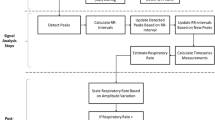Abstract
Objective
The non-invasive technique photopl- ethysmography (PPG) can detect changes in blood volume and perfusion in a tissue. Respiration causes variations in the peripheral circulation, making it possible to monitor breaths using an optical sensor attached to the skin. The respiratory-synchronous part of the PPG signal (PPGr) has been used to monitor respiration during anaesthesia, and in postoperative and neonatal care. Studies addressing possible differences in PPGr signal characteristics depending on gender or age are lacking.
Methods
We studied three groups of 16 healthy subjects each during normal breathing; young males, old males and young females, and calculated the concordance between PPGr, derived from a reflection mode PPG sensor on the forearm, and a reference CO2 signal. The concordance was quantified by using a squared coherence analysis. Time delay between the two signals was calculated. In this process, we compared three different methods for calculating time delay.
Results
Coherence values ≥0.92 were seen for all three groups without any significant differences depending on age or gender (p = 0.67). Comparison between the three different methods for calculating time delay showed a correlation r = 0.93.
Conclusions
These results demonstrate clinically important information implying the possibility to register qualitative PPGr signals for respiration monitoring, regardless of age and gender.
Similar content being viewed by others
References
Krieger B, Feinerman D, Zaron A, Bizousky F, 1986; Continuous non-invasive monitoring of respiratory rate in critically ill patients Chest 90: 632–634
Folke M, Cernerud L, Ekström M, Hök B, 2003; Critical review of non-invasive respiratory monitoring in medical care Med Biol Eng Comput 41: 377–383
Robins D, 1996; Principles & guidelines for respiratory monitoring on the general care floor. The Consortium on Respiratory Monitoring on the General Care Floor J Clin Monit 12: 411–416
Challoner AVJ, 1979; Photoelectric plethysmography for estimating cutaneous blood flow In Rolfe P, (eds.), Non-invasive physiological measurement Academic Press London
Tremper K K, Barker SJ, 1989; Pulse oximetry Anesthesiology 70: 98–108
Johansson A, Öberg PÅ, Sedin G, 1999; Monitoring of heart and respiratory rates in newborn infants using a new photoplethysmographic technique J Clin Monit 15: 461–467
Nilsson L, Johansson A, Kalman S, 2000; Monitoring of respiratory rate in postoperative care using a new photoplethysmographic technique J Clin Monit 16: 309–315
Nilsson L, Johansson A, Kalman S, 2005; Respiration can be monitored by photoplethysmography with high sensitivity and specificity regardless of anaesthesia and ventilatory mode Acta Anaest Scand 49: 1157–1162
Olsson E, Ugnell H, Öberg PÅ, Sedin G, 2000; Photoplethysmography for simultaneous recording of heart and respiratory rates in newborn infants Acta Paediatr 89: 853–861
Yoon G, Lee JY, Jeon KJ, Park KK, Kim HS, 2005; Development of a compact home health monitor for telemedicine Telemed JE Health 11: 660–667
Sonesson B, Hansen F, Stale H, Länne T, 1993; Compliance and diameter in the human abdominal aorta – The influence of age and sex Eur J Vasc Surg 7: 690–697
Johansson A, Strömberg T, 2000; Influence of tidal volume and thoraco-abdominal separation on the respiratory induced variation of the photoplethysmogram J Clin Monit 16: 575–581
Jönsson B, Laurent C, Skau T, Lindberg L-G, 2005; A new probe for ankle systolic pressure measurement using photoplethysmography (PPG) Ann Biomed Eng 33: 232–339
Sandberg M, Zhang Q, Styf J, Gerdle B, Lindberg L-G, 2005; Non-invasive monitoring of muscle blood perfusion by photoplethysmography. Evaluation of a new application Acta Physiol Scand 183: 335–343
Bernardi L, Radaelli A, Solda PL, Coats AJS, Reeder M, Calciati A, Garrard CS, Sleight P, 1996; Autonomic control of skin microvessels: assessment by power spectrum of photoplethysmographic waves Clin Sci 90: 345–355
Vegfors M, Ugnell H, Hök B, öberg PÅ, Lennmarken C, 1993; Experimental evaluation of two new sensors for respiratory rate monitoring Physiol Meas 14: 171–181
Johansson A, Hök B, 2004; Sensors for respiratory monitoring in sensors applications In öberg PÅ, Togawa T, Spelman F (eds.), Sensors in medicine and health care Wiley-VCH Verlag Wienheim
Gensini GF, Corradi F, 2000; Hypertension as a function of age Ital Heart J 1: 23–31
Bjarnegard N, Rydén Ahlgren A, Sandgren T, Sonesson, Lanne T, 2003; Age affects proximal brachial artery stiffness; differential behavior within the length of the brachial artery? Ultrasound Med Biol 29: 1115–1121
Nilsson L, Johansson A, Kalman S, 2003; Macrocirculation is not the sole determinant of the respiratory induced variations in the reflection mode photoplethysmographic signal Physiol Meas 24: 925–937
Nilsson L, Johansson A, Kalman S, 2003; Respiratory variations in the reflection mode photoplethysmographic signal. Relations to peripheral venous pressure Med Biol Eng Comput 41: 249–254
Author information
Authors and Affiliations
Corresponding author
Additional information
Nilsson L, Goscinski T, Johansson A, Lindberg L-G, Kalman S. Age and gender do not influence the ability to detect respiration by photoplethysmography.
Rights and permissions
About this article
Cite this article
Nilsson, L., Goscinski, T., Johansson, A. et al. Age and Gender Do Not Influence the Ability to Detect Respiration by Photoplethysmography. J Clin Monit Comput 20, 431–436 (2006). https://doi.org/10.1007/s10877-006-9050-z
Received:
Accepted:
Published:
Issue Date:
DOI: https://doi.org/10.1007/s10877-006-9050-z




